News //
LKCNHM hosted our inaugural photography and illustration contest titled ‘Eyes of a Naturalist’ a few months ago! Contestants were to submit either a photograph or an illustration which reflects the work of a known naturalist—past or present, local or overseas. A naturalist is someone who observes, studies, and records the natural environment.
Read more about the contest here: https://lkcnhm.nus.edu.sg/lkcnhms-inaugural-eyes-of-a-naturalist-contest-workshops/
Thank you to all contestants who participated in the LKCNHM Eyes of a Naturalist Contest! We received a total of 81 entries across the two categories. After a tough judging process, we have our winners for the contest!
All contestants are also entitled to our lucky draw. And here are our eight lucky draw winners: Tan Shu Wen Rosemarie, Joel Mathews, Chee Wei Teck, Veron Pwa Keay Hoon, Qiru Lin, Lim Keng Huat Joseph, Steven Tjokrokentjono, and Tan Jian Qing. Winners have been contacted by LKCNHM.
Without further ado, here are the winning entries for the Photography Contest!
1st prize

Pacific swallow feeding fledgling
By Tan Tze Siong
ISO 1600 f/5.6 1/4000 sec 850mm
Based on naturalist Dr Wee Yeow Chin
‘They stay on stable ground while the parent hovers around transferring food into their gaping beak while on the wing.’ Dr Wee Yeow Chin observed this common resident bird in his excellent blog: Bird Ecology Study Group (BESG). Dr Wee, a trained biologist, is a well-respected pioneer green advocate in Singapore. He has made significant contributions to the local green movement through his extensive participation and leadership in organisations, as founding President of the Nature Society (Singapore), and Honorary Museum Associate of the Lee Kong Chian Natural History Museum, among others. The BESG was started by Dr Wee in 2005. Its objectives include to fill in the lack of information regarding behaviour of local birds, and to encourage the dissemination of information via the internet and publications in popular magazines and scientific journals. As a novice birder in the 2000s, the blog was a boon to me. There were few available books on local birds, which focus mainly on identification, and I was hungry for more material. BESG bridges the gap, documenting and sharing information on all aspects of avian conduct, some of which were described for the very first time by citizen scientists. The entry on ‘Pacific Swallow feeding fledgling’ was published in 2006, and I long dreamt of documenting the behaviour on film. More than 10 years later I witnessed the captivating scene, occurring exactly as had been described, and immortalised the moment on camera. Thank you, Dr Wee.
2nd Prize
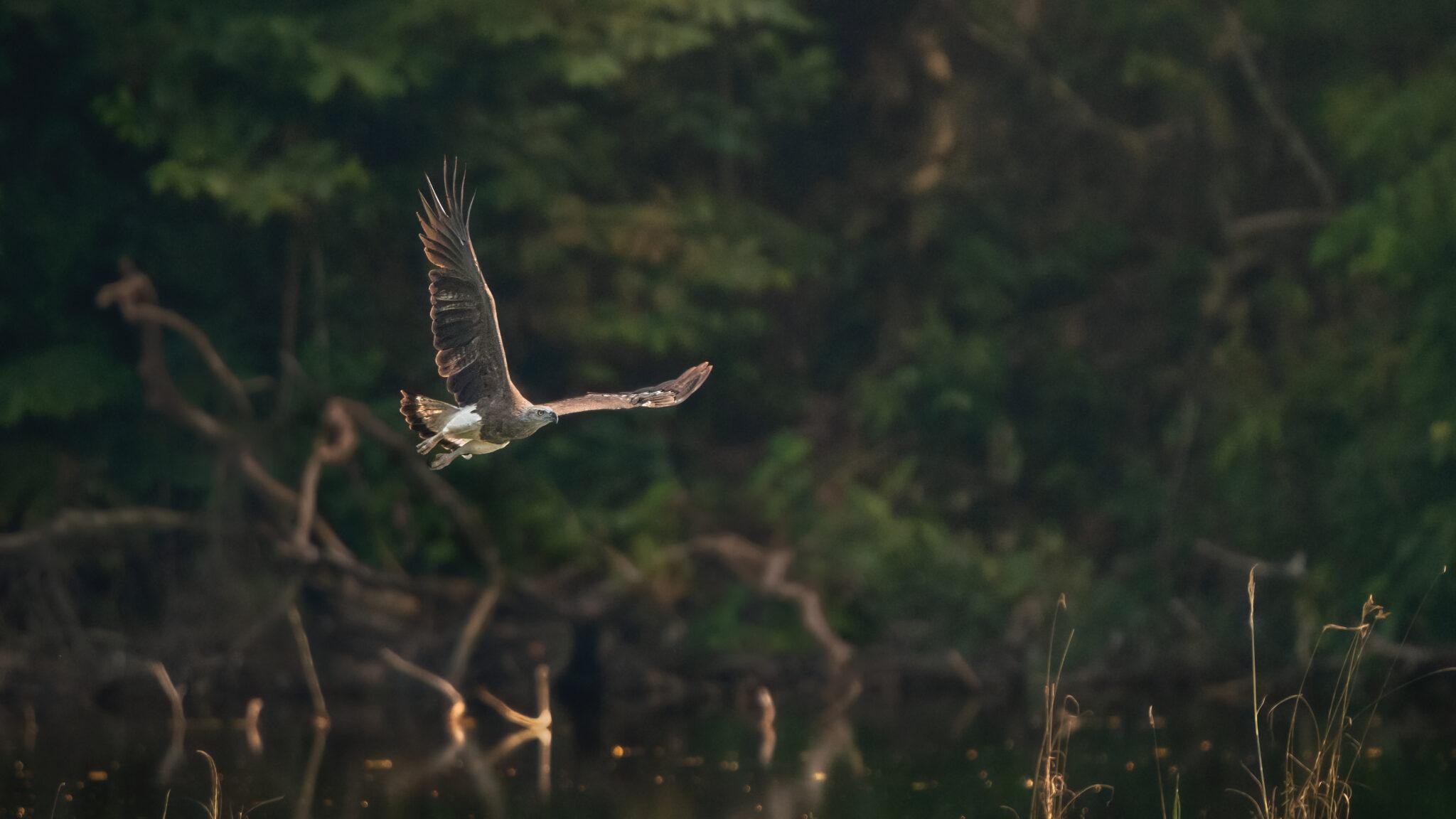
A grey-headed fish-eagle flying across the quarry to return to its roosting spot as the sun slowly sets
By Lee Zhi Heng
ISO 6400 f/6.3 1/3200 sec 600mm
Based on naturalist Dr Yong Ding Li
As recently as a decade ago, grey-headed fish-eagle was listed as critically endangered in the Red Data Book of Singapore and little was known about the small local population. Its status in Singapore could have been due to our island’s rapid modernisation over the past few decades which wiped out forests and suitable reservoir habitats where the eagles breed. Dr Yong Ding Li realised that there was almost no research done on this species in Singapore and decided to carry out field surveys from 2009 to 2011, studying prey items, behaviour and habitats in relation to the grey-headed fish-eagle. His studies concluded that the species was adapting well and feeding on a plethora of food sources in a few of our inland reservoirs. He also found that the species is able to thrive near urban areas and that its population is expectedly rising. As such, he recommended a revised threat status of “nationally vulnerable”, which the 3rd version of the Red Data Book eventually updated its status to in 2023, reflecting a more accurate depiction of the increasing population today. This photograph I have submitted shows the grey-headed fish-eagle spreading its wings and taking flight towards the direction of the sun, representing the growth and revival of this once rare species in Singapore. It also serves as a symbol of hope for us that we can still help other endangered wildlife in Singapore and bring them back to their former glory through conservation efforts.
3rd Prize

A king cobra (Ophiophagus hannah) consumes a gold-ringed cat snake (Boiga dendrophila) alive along Upper Seletar Reservoir
By Goh Seng Chuen Elijah
ISO 220 f/5.6 1/125 sec 64mm
Based on naturalist Romulus Whitaker
Romulus Whitaker’s contributions to herpetology are as diverse as the reptiles he studies, but perhaps he is best known for his research on king cobras in the Western Ghats. As the founder of the Agumbe Rainforest Research Station, his field research has enhanced our ecological understanding of this often misunderstood species. For example, he spearheaded the use of radio telemetry to track king cobras, resulting in the maiden documentation of a translocated cobra travelling over 90 kilometres in nine months, suggesting that “rescued” cobras released far from their home could become heavily disoriented. Besides improving conservation policies, his documentations of king cobra behaviours like nest-building have helped challenge the misconception of the species as merely bloodthirsty monsters. Instead, Romulus shows that king cobras are complex, fascinating animals with a rich natural history deserving of our admiration. My photo provides a snapshot of a king cobra in the midst of consuming a gold-ringed cat snake, halfway in its hour-long struggle with its living prey. While such acts of predation are often unfortunately portrayed as vicious and cruel, my photo aims to give dimensionality to these misunderstood creatures even during their intense hunts. To hunt prey as challenging as the cat snake reflects millennia of evolution, evident in the cobra’s honed instinct, powerful muscles and intoxicating venom. Similar to Romulus’ work, I hope my photo shows the beauty of the king cobra even in its lethal adaptations.
Consolation Prizes
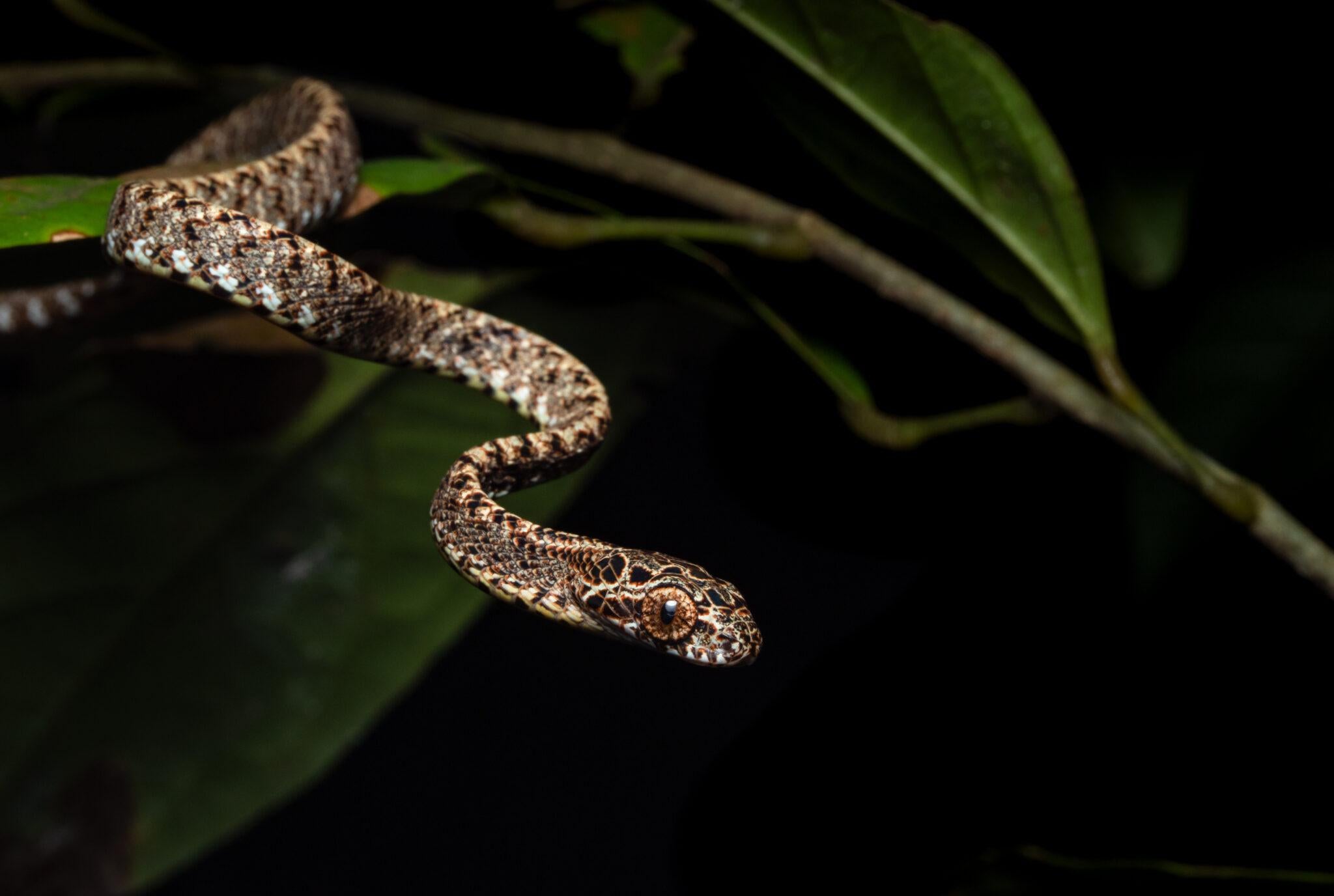
A neonate Boiga jaspidae ventures out to the edge of the forest. Charming a group of wildlife enthusiasts with its adorability, it was warmly welcomed
By Emmanuel Goh Shyue Chian
ISO 250 f/14 1/250 sec 60mm
Based on naturalist Subaraj Rajathurai
Uncle Subaraj, as he was fondly referred to and remembered by, was a pioneer and household name in Singapore’s conservation scene. Well known for his efforts in protecting our nature areas, such as Sungei Buloh Wetlands Reserve, his large figure was dwarfed by his vast knowledge of biodiversity. In turn, his knowledge was dwarfed by his big heart, for it was always in his warm and gentle nature to share and educate people of all ages about the natural world. In an age where birds were highlighted, he formed the Vertebrate Study Group to support field studies into mammals, reptiles, amphibians and freshwater fishes. The baselines surveys that he conducted for these animal groups would be an important first step and resource that would promote the conservation efforts seen today. He also encouraged the formation of the Herpetological Society of Singapore, without which I would never have been the herper I am today. This neonate Boiga jaspidae, which signifies hope for this endangered species in Singapore, is dedicated to his lifelong work in championing for our green spaces.
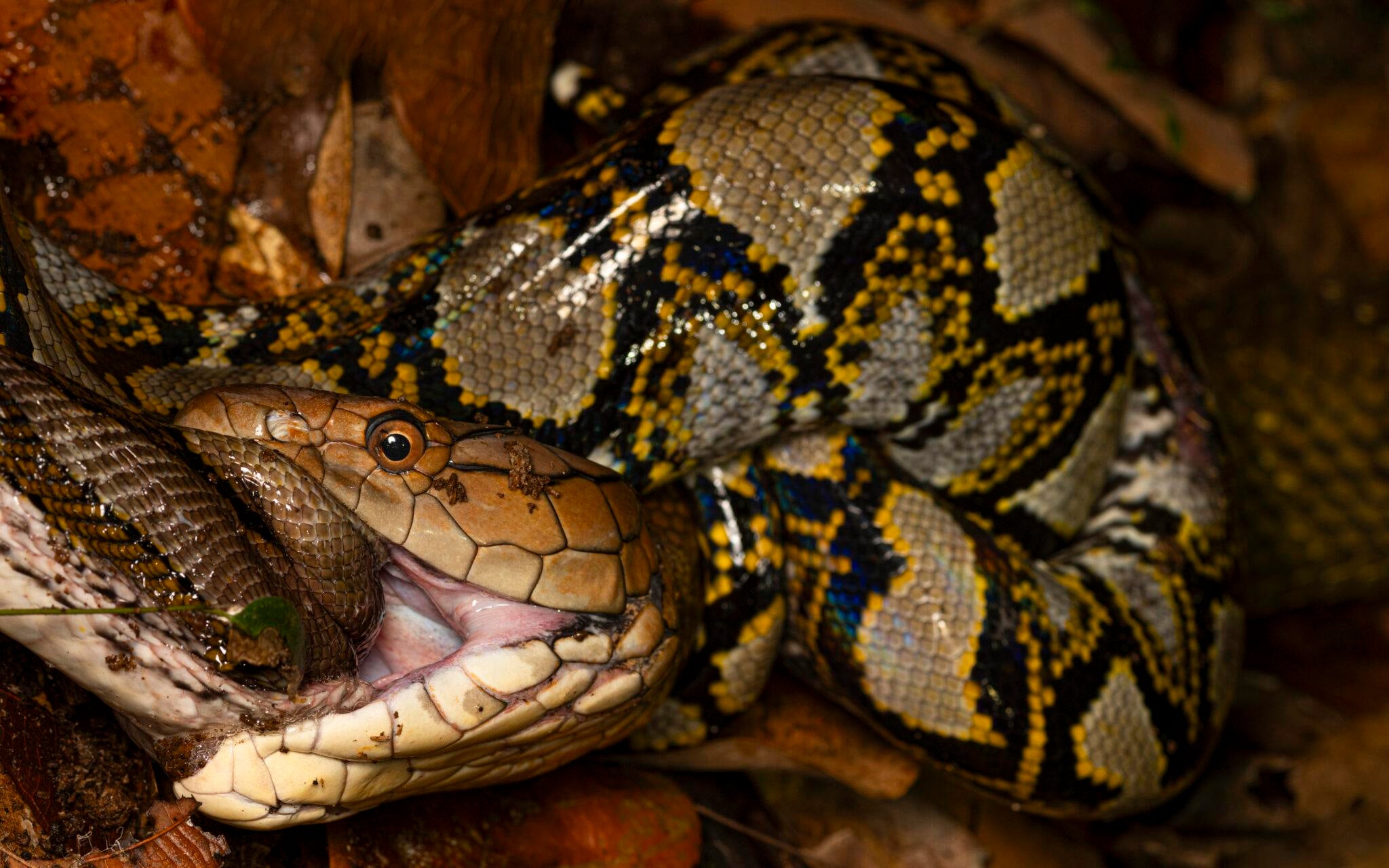
Clash of the Titans. This battle happened between a 4-metre-long king cobra and a 5-metre-long reticulated python that lasted over 7 hours
By Chan Jiong Hao
ISO 200 f/9.0 1/200 sec 100mm
Based on naturalist Patrick Russell
Mr Patrick was a herpetologist who worked in India in the late 1700s and was concerned about snake bites. He is one of my heroes as he got me interested in snakes. Like most people, growing up, I used to have a fear of snakes but as I grew up, I started to realise how beautiful snakes can be. I learnt about how important they are to the environment and what roles they play in the wider ecosystem. Mr Patrick inspired me to be curious about our scaly friends and I am forever indebted. This photograph shows a clash between two titans. A 4-metre king cobra and a 5-metre reticulated python. The entire process lasted 7 hours, and the reticulated python was a true fighter as it refused to die and cling onto its dear life. In the photograph, the python was trying its best to squeeze the life out of the king cobra so that it would not be its dinner.

Anthos, Porthos, and Aramis – The 3 weavers poised upon a leaf, holding it down while the colony builds its nest
By Tomy Arden Phang
ISO 2500 f/5.6 1/200 sec 90mm
Based on naturalist Mikey Bustos
While Anthos may not be the brawniest of the trio, he makes up for being the antgineer he is. As Porthos grappled a good grip of the leaf, Anthos held a steady pivot of the corner, allowing Aramis to swiftly fold the far side. “Looks like we’ve got ourselves a brand-new room!” cheered Anthos as his inseparable buddies clinched the last gap of leaf closed. This photograph would have just been about weaver ants building a nest of leaves if it weren’t for Mikey Bustos who inspired me to forge a deeper connection with nature through captivating narratives. Mikey, a dedicated ant-keeper, documents the lives of his ant colonies into videos he posted on his YouTube channel AntsCanada. His storytelling prowess transforms these tiny insects into engaging characters within his educative ant videos. I was enamoured by the video where he showed his fire ants colony: The Fire Nation building their endless tunnels. His unique macro perspective and his ability to infuse depth into his storytelling are qualities I aspire to emulate. So, behold: Anthos, Porthos, and Aramis the inseparable trio of weaver ants wrestling with the unwavering fold of leaf! Would you join them in their next adventure?
Congratulations to the winners and thank you for your stunning photographs!
Next, here are the winners of the Illustration Contest!
1st Prize
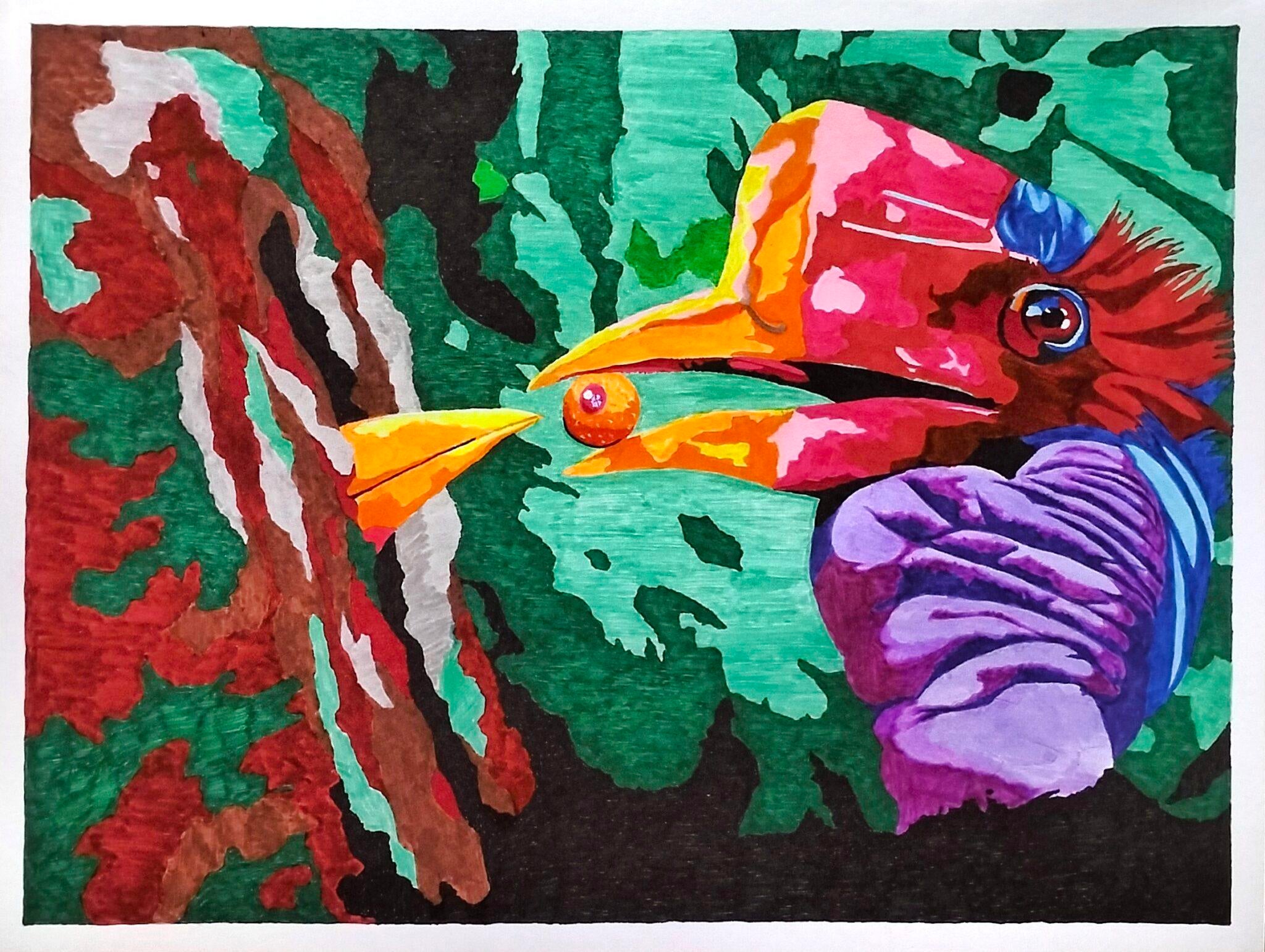
Helmeted hornbill, a species threatened by reproduction complications
By Beh Lih Khiang
Markers on paper
Based on naturalist Dr Ravinder Kaur
Helmeted hornbill is a critically endangered species threatened by deforestation and logging, in addition to hunting for their solid casque. Hornbills are bird species which reproduce in tree cavities. The absence of mature trees due to logging means that there will be less natural tree cavities for them to nest and reproduce. Helmeted hornbill has one of the longest nesting periods among all hornbill species, making the situation much more dire with their naturally slow breeding rate. The helmeted hornbill also has a specific diet (primarily fig) and nest tree preferences for primary forest, as indicated from research done by Dr. Ravinder Kaur, which complicates the matter of its reproduction success. Dr. Ravinder Kaur is a hornbill researcher and conservationist in Malaysia. She founded Gaia, an NGO focusing on hornbill conservation. To assist the reproduction of hornbills, Dr. Ravi and her team have set up artificial nest boxes in the forest and helped repair natural tree cavities. Current artwork focuses on the theme of helmeted hornbill’s reproduction, in which a male is illustrated to be feeding a fig fruit to a female sealed within a nest in the tree cavity.
2nd Prize
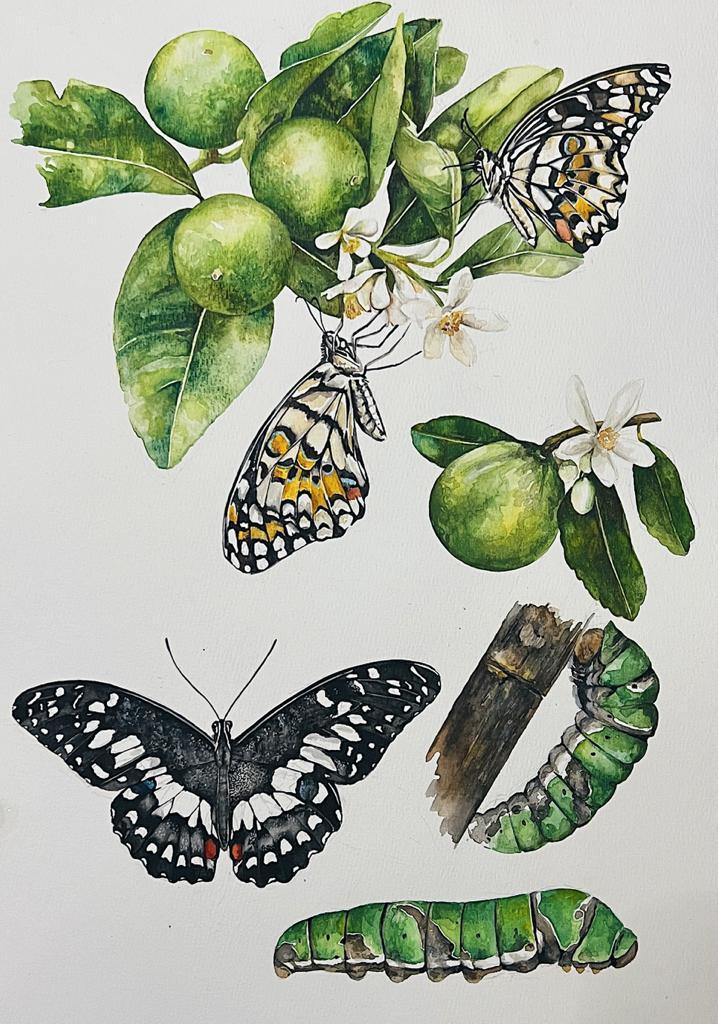
The vibrancy of nature and the delicate interconnectedness of species
By Melissa Ngein Wen Wen
Watercolour on paper
Based on naturalist Maria Sibylla Merian
Channeling the spirit of Maria Sibylla Merian, the German naturalist, my art piece is a visual ode to the intricate world of butterflies and their life cycle. Capturing the essence of Merian’s meticulous drawings, my artwork unfolds the mesmerising metamorphosis of a butterfly, tracing its journey from a humble caterpillar to the ethereal beauty of its final form. Each stage is a testament to the harmonious intersection of scientific precision and artistic finesse, mirroring Merian’s own approach to entomology. Through vibrant hues and intricate linework, I aim to convey the vibrancy of nature and the delicate interconnectedness of species that fascinated Merian. A sense of wonder and appreciation for the natural world, echoing Merian’s dual role as a scientist and artist. I hope my art piece pays homage to Maria Sibylla Merian, weaving a visual narrative that intertwines scientific curiosity with the timeless beauty of butterflies in their ecological tapestry.
3rd Prize
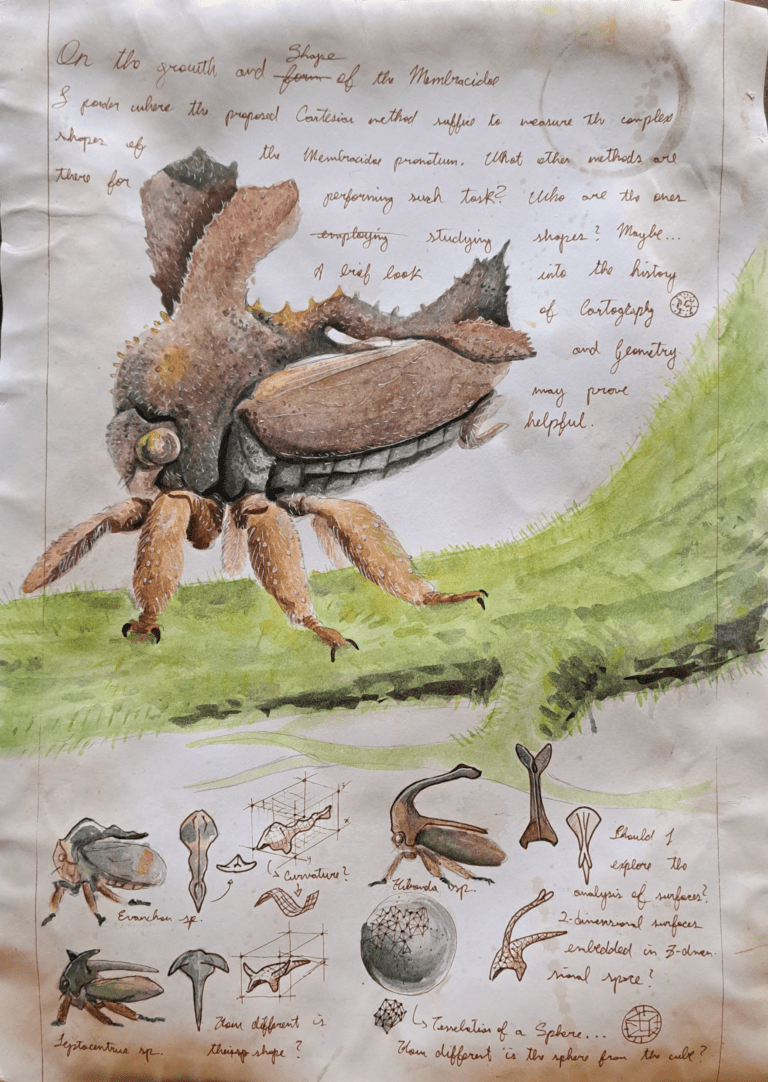
Considerations about the study of the complex shapes of the Membracidae pronotum inspired by the work of Sir D’Arcy Wentworth Thompson
By Diego Pitta de Araujo
Watercolour, archival ink, white gel ink, coffee on paper
Based on naturalist D’Arcy Wentworth Thompson
Sir D’arcy Wentworth Thompson was a biologist best known for his work “On Growth and Form”, in which he proposed mathematical ways to measure morphological changes in the development and diversification of species. His proposal was later formalised in a set of statistical methods used for morphological analysis, Geometric Morphometrics. Here, I present an illustration that simulates the notebook of a naturalist interested in discussing Sir Thomson’s proposal in the light of complex biological shapes. The naturalist, studying the diverse shapes of the treehoppers (Membracidae) pronotum, pens his thoughts about where Geometric Morphometrics would be the ideal method for describing the pronotum and deriving values of shape differences between species. While venturing into new fields, such as cartography, topology and shape analysis, the naturalist takes notes on other ways in which he may achieve his goals. “On Growth and Form” was a work that influenced my own thinking about the analysis of animal morphology and my interest in applying three-dimensional shape analysis as a way to quantitatively describe morphological differences and the evolution of complex anatomical traits. The illustration was made with a mixture of media (watercolour, archival ink, white gel ink, coffee), on a 160gms drawing paper. An aged paper effect was achieved using a cloth damp with watercolor followed by ironing. The word “form” was intentionaly replaced by “shape”. The coffee stain highlights the words “measure the complex”, playing with the idea of measuring shape complexity.
Consolation Prizes

Resting in a tranquil environment, this golden orb spider (Nephila pilipes) waits patiently on her eight legs extended. Her yellow and black abdomen and her pedipalps are distinctive
By Bong Chai Lee
Acrylic on canvas
Based on naturalist Johan Christian Fabricius
Johan Christian Fabricius a Danish zoologist born on January 7th, 1745. He was a student of Carl Linnaeus and specialized in the study of “Insecta”. Fabricius named almost 10,000 animal species and is considered one of the most significant entomologists of the 18th century. He laid the foundation for modern insect classification. Fabricius believed that the environment played a decisive role in the development of life. The golden orb spider, Nephila pilipes (Fabricius, 1793), is a spider species commonly found in the primary and secondary forests of Singapore. Its remarkable ability to weave large, spectacular webs with spider silk makes it famous. This female N. pilipes measures approximately 5cm from head to abdomen and has four pairs of legs, with the third pair being the shortest, roughly half the length of the first pair. The legs can be divided into seven segments. The coxae are black, while the other lateral margins are dark brown, with a central yellow-brown section. The remaining segments range in color from very dark brown to black. The inter-segmental membranes are bright yellow with yellow spot coloration on the underside of its legs. The abdomen is yellowish-black, with the median area appearing yellow from a dorsal view, with a black longitudinal band running through the middle. N. pilipes has eight eyes arranged in two rows of four, and the pedipalps are red.

Crocodile on Tape
By Van Wangye Shiming
Pencils, pen, watercolor, acrylic, gouache and colored pencils on green coloured paper
Based on naturalist Ria Tan
Ria Tan is not a scientist but is known for her years of experience monitoring Singapore’s shores. The title of the artwork is playing with words of the common name of these two species, crocodile pipefish (Syngnathoides biaculeatus) which is also called alligator pipefish or double-ended pipefish clinging onto a stalk of tape seagrass (Enhalusacoroides). This is a male crocodile pipefish holding fertilised eggs at the pouch at his abdominal area. Together with many other seahorse species, it has been heavily targeted by the Chinese community for traditional Chinese medicine trade. Pipefish in mandarin is generally called sea dragon (Hai Long). It is also kept as an aquarium pet. Tape seagrass is a food source for green sea turtles, dugongs and other herbivorous marine fauna. Tape seagrass meadow also serves as a refuge or nursery for many fishes.
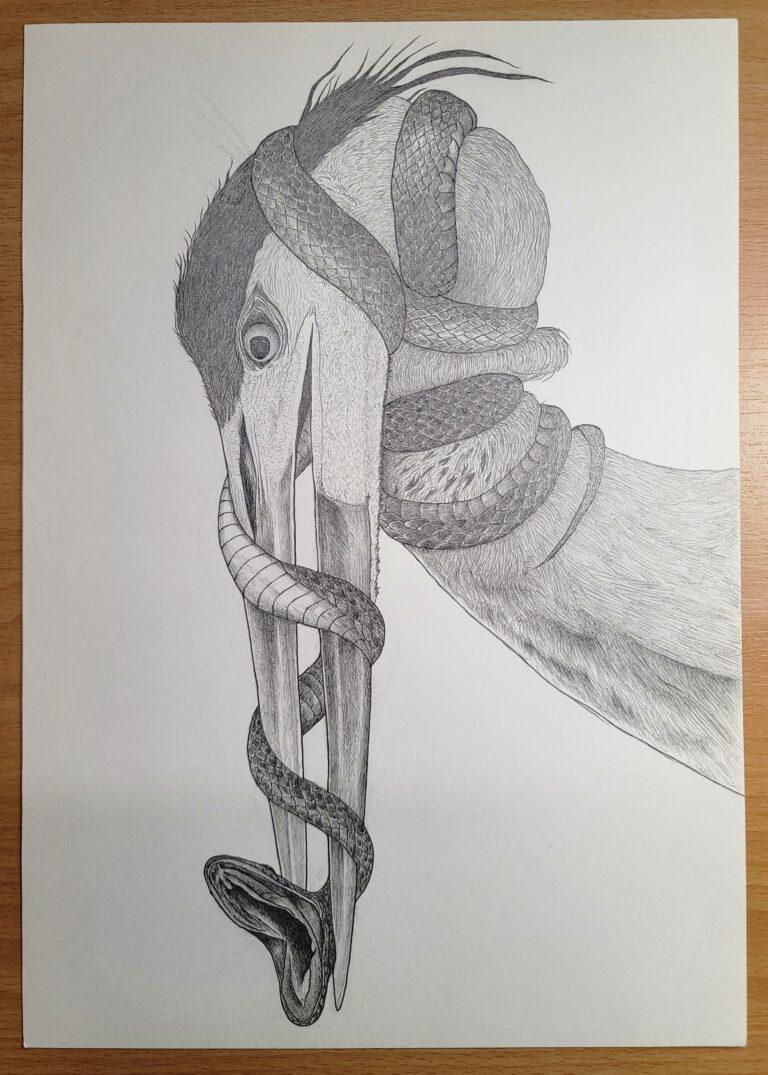
Nature’s Polemic: A graphite retelling of Andy Glogower’s merciless and unyielding wildlife tussle
By Nayeon Kim
4B pencil on paper
Based on naturalist Andy Glogower
This entry is a graphite illustration reflecting the work of an award-winning wildlife photographer Andy Glogower. The original photo is dubbed “Epic Battle,” featuring a great blue heron tangled up with a Florida green water snake. For my own work, I retained the highly imposing visuality of a physically entwined struggle between a hefty bird and a relatively feeble snake; this image beguiles the viewer through its shift of mainstream representation of snakes where these scaly creatures often play the unilateral predators’ role. Also, I replicated the vertical composition which pushes the prey (its head in particular) to the very bottom tip of the frame as it highlights both the ferocity of the heron and the beautiful bodily curves of the snake. Based on Glogower’s insight, I sought to intensify the dog-eat-dog urgency and gravity of the situation by modifying the snake’s expression into a desperate shriek. Meanwhile, repeating the coil several times more around the bird’s neck is intended to make it choke—perhaps, to death. This handicap blunts the mild superiority of the heron over the snake in the original photograph, and ultimately blurs the dichotomy between ‘predator’ and ‘prey’. In the original work, the heron would probably end up feeding on the snake; the predator will conquer. For my drawing, however, the ending is unknown. The answer to the question, ‘Who would win?’, is nebulous because I evened out power dynamics. Two entities, both predator “and” prey, seek each other’s end.
Which photographs or illustrations were your favourites? 🤔
Thank you again for all your support for the competition! We are preparing an exhibition to display all the beautiful winning entries. Keep your eyes peeled for updates! 👀